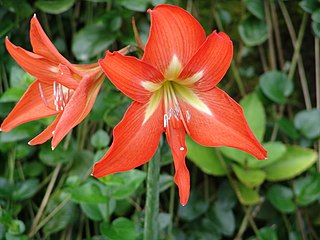
Hippeastrum is a genus of about 90 species, and over 600 hybrids and cultivars, of perennial, herbaceous and bulbous plants, native to tropical and subtropical regions of the Americas, from Mexico south to Argentina and on some islands in the Caribbean. The majority have large, fleshy bulbs—usually about the size of a softball—and tall, broad, strap-like leaves that are (generally) evergreen, and large red or purple flowers. Numerous colors and cultivars have been created over the past hundred years.

Freesia is a genus of herbaceous perennial flowering plants in the family Iridaceae, first described as a genus in 1866 by Christian Friedrich Ecklon (1886) and named after the German botanist and medical practitioner, Friedrich Freese (1795-1876). It is native to the eastern side of southern Africa, from Kenya south to South Africa, most species being found in Cape Provinces. Species of the former genus Anomatheca are now included in Freesia. The plants commonly known as "freesias", with fragrant funnel-shaped flowers, are cultivated hybrids of a number of Freesia species. Some other species are also grown as ornamental plants.

Trachycarpus fortunei, the Chinese windmill palm, windmill palm or Chusan palm, is a species of hardy evergreen palm tree in the family Arecaceae, native to parts of China, Japan, Myanmar and India.

Amaryllis belladonna, the Jersey lily, belladonna-lily, naked-lady-lily, or March lily, is a plant species native to Cape Province in South Africa but widely cultivated as an ornamental. It is reportedly naturalized in many places: Corsica, Portugal, the Azores, Madeira, the Canary Islands, the Scilly Isles of Great Britain, the Democratic Republic of the Congo, Ascension Island, Australia, New Zealand, Mexico, Cuba, Haiti, the Dominican Republic, Chile, California, Texas, Louisiana, Mississippi, Michigan and the Juan Fernández Islands.
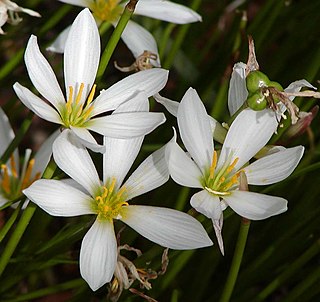
Zephyranthes is a genus of temperate and tropical bulbous plants in the Amaryllis family, subfamily Amaryllidoideae, native to the Americas and widely cultivated as ornamentals. Following the expansion of the genus in 2019, which now includes the genera Habranthus and Sprekelia, there are about 200 recognized species, as well as numerous hybrids and cultivars. Common names for species in this genus include fairy lily, rainflower, zephyr lily, magic lily, Atamasco lily, and rain lily.

Yucca gloriosa is a species of flowering plant in the family Asparagaceae, native to the southeastern United States. Growing to 2.5 m (8 ft), it is an evergreen shrub. It is widely cultivated as an ornamental for its architectural qualities, and has reportedly become established in warmer climates in the wild in various parts of the world.

Zephyranthes carinata, commonly known as the rosepink zephyr lily or pink rain lily, is a perennial flowering plant native to Mexico, Colombia and Central America. It is also widely cultivated as an ornamental and naturalized in the West Indies, Peru, Argentina, Brazil, the southeastern United States from Texas to Florida, Zimbabwe, South Africa, China, Korea, the Ryukyu Islands, Assam, Nepal, Bhutan, Sri Lanka, Solomon Islands, Queensland, Society Islands, Kiribati, and Caroline Islands.

Sprekelia is a genus of Mesoamerican plants in the Amaryllis family, subfamily Amaryllidoideae. Sprekelia plants are sometimes called Aztec lilies or Jacobean lilies although they are not true lilies. This genus has been submerged in Zephyranthes, but as of January 2023 is accepted by Plants of the World Online with a single species, Sprekelia formosissima, endemic to Mexico.

Zephyranthes candida, with common names that include autumn zephyrlily, white windflower, white rain lily, and Peruvian swamp lily, is a species of rain lily native to South America including Argentina, Uruguay, Paraguay, and Brazil. The species is widely cultivated as an ornamental and reportedly naturalized in many places.

Zephyranthes robusta, synonym Habranthus robustus, commonly known as the Brazilian copperlily, pink fairy lily or the pink rain lily, is a species of herbaceous flowering bulb. It is native to Brazil, Argentina and Uruguay, but is now naturalized in Florida, Colombia, South Africa, and Mauritius.

Linnaea is a plant genus in the honeysuckle family Caprifoliaceae. Until 2013, the genus included a single species, Linnaea borealis. In 2013, on the basis of molecular phylogenetic evidence, the genus was expanded to include species formerly placed in Abelia, Diabelia, Dipelta, Kolkwitzia and Vesalea. However, this is rejected by the majority of subsequent scientific literature and flora.

Digitalis grandiflora, the yellow foxglove, big-flowered foxglove, or large yellow foxglove, is a species of flowering plant in the genus Digitalis, family Plantaginaceae. It is native to southern Europe and Asia. In mountains it grows on warm, bushy slopes or areas left after logging. The Latin specific epithet grandiflora means “large flowered”.

Coreopsis grandiflora is a North American species of perennial plant in the family Asteraceae. The common name is large-flowered tickseed. It is found in eastern Canada and much of the United States, especially the south-central part of the country. The species is widely cultivated in China and naturalized there.

Fritillaria pallidiflora is an Asian species of bulbous flowering plant in the lily family Liliaceae, native to Xinjiang, Kyrgyzstan and Kazakhstan. The common name frequently used is Siberian fritillary, a misnomer because the species does not grow in the wild in Siberia.
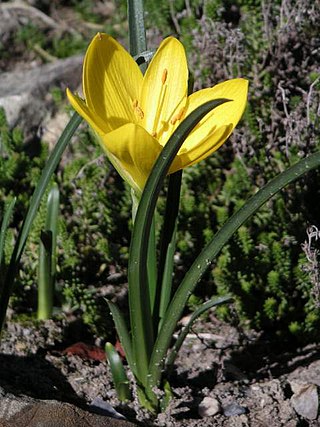
Sternbergia is a genus of Eurasian and North African plants in the Amaryllis family, subfamily Amaryllidoideae.
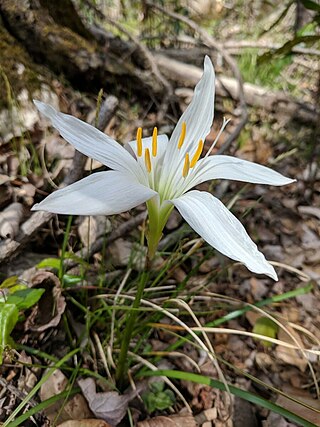
Zephyranthes atamasca, commonly known as the atamasco-lily or more generally a rain-lily, is native to the southeastern United States. It grows in swampy forests and coastal prairies, preferring acid boggy soils rich with leaf mold. Following the appearance of broad, grassy leaves in early winter, it blooms in March or April. It has several narrow, linear basal leaves about 0.5 in (13 mm) wide and 10–15 in (25–38 cm) long. Its native range extends from Florida north to Maryland and west to Mississippi. The species is also naturalized in Bermuda and in the Mariana Islands. Both its leaves and bulbs are poisonous.
Zephyranthes puertoricensis, known commonly as the Puerto Rico zephyr lily, is a species of flowering plant in the amaryllis family, Amaryllidaceae, subfamily Amaryllidoideae. It is native to the West Indies, Panama, Colombia, Suriname and Venezuela. It is a member of low elevation grasslands communities and moist forest habitat.
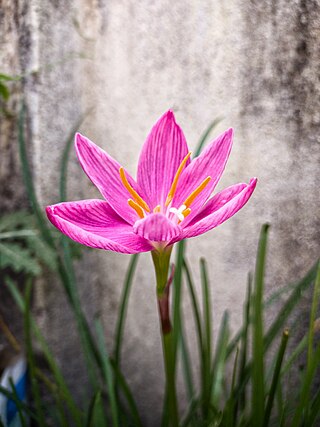
Pink rain lily, pink fairy lily, pink zephyr lily, and pink magic lily are the common names of several species of flowering plants belonging to the genera Zephyranthes and Habranthus :

Zephyranthes rosea, commonly known as the Cuban zephyrlily, rosy rain lily, rose fairy lily, rose zephyr lily or the pink rain lily, is a species of rain lily native to Peru and Colombia. They are widely cultivated as ornamentals and have become naturalized in tropical regions worldwide. Like all rain lilies, they are known for blooming only after heavy rains.























